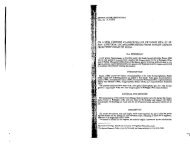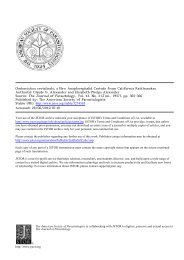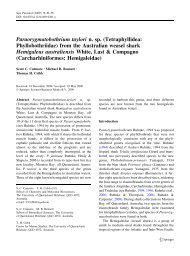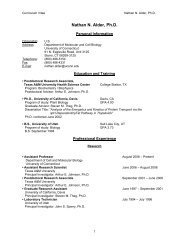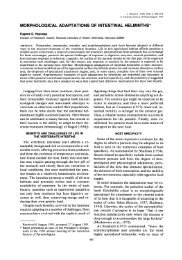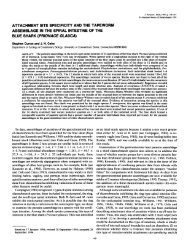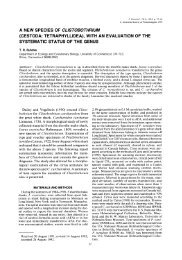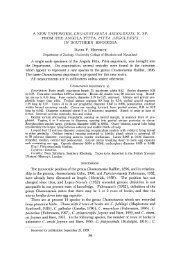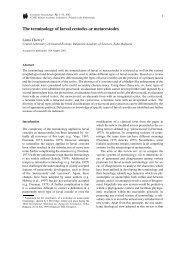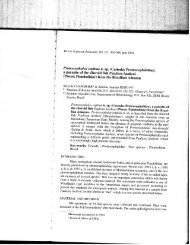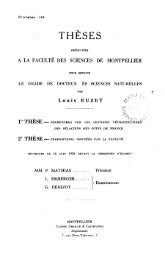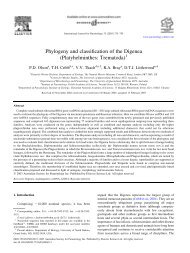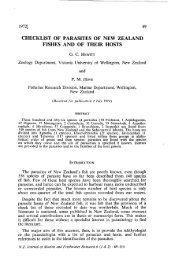PEARL OYSTER FISHERIES MARINE BIOLOGY OF CEYLON,
PEARL OYSTER FISHERIES MARINE BIOLOGY OF CEYLON,
PEARL OYSTER FISHERIES MARINE BIOLOGY OF CEYLON,
Create successful ePaper yourself
Turn your PDF publications into a flip-book with our unique Google optimized e-Paper software.
THE PARASITES <strong>OF</strong> THE <strong>PEARL</strong> <strong>OYSTER</strong>. 101head end are (i rows of about 50 hooks about 0031 niillim. long. The head-lappetsare rounded behind and abut on one another in the lateral line. There are 6 lipson the head. The oesophagusis of4-5the entire length, a id the conieally pointed'(ail end is:> 4 of the total length. Four tubes lie beneath the anterior end of theoesophagus; these are 2 - 05 millinis. in length, and, as is characteristic for the genusCheir acanthus, these are shorter than the (esophagus and show externally a layerof spiral muscles.The larvas were found encysted in the adductor muscle.The adult of these forms is in allprobability the Cheiracanthus uncinatus,described and figured by Molix under the name Echinocephaliis uncinatus. It isfound in the alimentary canal of Trygon pastinaca and of Trygon brucco.This second Nematode infesting the pearl oysteris a robust species, readilydistinguishable at sight from the Ascarid, by its comparative shortness and the subglobularenlargement of the cephalic extremity, which is armed with 6 concentricrings of backwardly-directed spines (Plate III, figs. 41, 44, 45). This globularcephalic inflation is characteristic, but at times it appears in a deflated condition, asshown in Plate III., fig. 45, when the form becomes that of a truncated cone.To the naked eye it appears when lying in its cyst of a faint pinkish tint, undermagnification the alimentary canal is seen to be of a dirty pale-yellowhue. Thecolourless transparent tissue lining the body wall has a distinct areolar appearance,due to the presence of large saccate cells. The bodyis smooth, with no trace ofannulation.This Nematode favours exclusively as its habitat the substance of the adductormuscle, lying coiled up therein in an ovoid cyst. Plate III., fig. 47, shows some of theusual regionsin the muscle where it is found. Its occurrence is strictly limited tothis particular organ, but occasionallyit would appear to become freed from itsenvelope and to leave the muscle, as instances occurred of this species being entombedin the nacreous lining of the shell. In several cases the coverino- film of nacreobscured scarcely anything of theouter form of the worm's body, the globular headand curved and pointed tail being especially conspicuous.Later stages have been found by one of us in the trigger fishes Balistes mitisand B. xtellatus, both pearl oyster-eating species, as proved by the presence of theshell fragments in the stomach.This spinous-headed Nematode is found both in the alimentary canal and in thevisceral cavityof Balistes. In the latter case, where it is much the more frequentlyfound, it burrows in the peritoneal membranes and adjacent connective-tissue.Judging from this habitat, it would appear to use its spine-armed cephalic extremityas a burrowino; organ.It is most probable that the adult also lives in some species of Trygonwhich areknown to feed on file fish, and also on pearl oysters.Statistics and Details. In all the cases noted below the Nematode was found inthe adductor muscle one Nematode in each case (Plate III., fig. 47).



